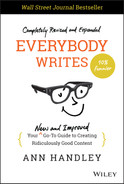26
Keep It Simple—But Not Simplistic
Business—like life—can be complicated.
Products are a lot to explain. Concepts? Convoluted.
Good content knows all that. Good content coolly surveys the complexity and chaos and then dons a cape and charges at the challenge like a superhero:
- Deconstructing the complex to make things easily understood!
- Sanding off the rough edges of corporate Frankenspeak!
- Reverse-engineering what needs reversing to find the choicest of concise, simple, accessible nuggets!
“Simple” doesn't mean dumb. It means you're not making your reader work too hard. It means being the customer's advocate.
A bit of wisdom from my journalism days: No one will complain that you've made things too simple to understand.
Simple springs from empathy and a reader-centric point of view and all of the things we've talked about already.
But text is only part of it. How is your content presented and packaged? What's around your content? Who is your content hanging out with?
- Find the best fit for your message. Do we need more or fewer words? Would a chart or graphic or visual convey an idea more simply? Do we need to show an executive's face? Could we use a video here, too?
- Slow the scrollers. A visitor to your website reads only 28% of the words on a page—sometimes as little as 20%, according to a study by NN Group.1
It's an old study—from 2008. But given the pace of modern life, I can't imagine we're paying any more attention now.
We can help improve on that 20-ish percent by writing for the scrollers*: Short sentences. Short paragraphs.
And in formatting: Clear copy hierarchy. Subheads. Bolding. Bullets. Text variation (intelligent use of SHOUTY CAPS, italic, bolding, etc.). White space.
Actually, white space is so important let's break that out in a separate bullet…
- Let white space give your text oxygen. Large chunks of text are formidable and impenetrable to read, especially online. It feels hard. Your reader will skip ahead.
White space gives your glorious words the air and light they need to breathe and thrive.
Inhale. Exhale.
Give your sentences and paragraphs room to relax—instead of being stacked on top of one another like backpackers in a budget hostel.
Ironically, the more scannable your content, the more of it gets read.
- Add images like you picked up a year's supply at a BOGO sale. Blog posts with 10+ images are nearly twice as likely to report strong results, according to an annual study of blogging effectiveness by Orbit Media.2
That sounds like a lot, until we remember that “images” can be anything from charts to video to screenshot to a pull quote to a contributor's photo.
Add a visual at every scroll depth—or every 75–100 words, suggests BuzzSumo. It analyzed one million articles and found that articles with images at that cadence are shared twice as often as those with fewer images.3
- Design with the words. Make your words be the hero of a design rather than piped onto a finished layout, like the way a supermarket baker pipes a message onto a prebaked birthday cake.
If your designer suggests they could just “bump down the font size …” to accommodate your text, it's too late.
Pasting words into a blank space is called the lorem ipsum approach—a name that refers to the nonsense Latin text that printers and typesetters have used since the 1500s as placeholder text.
Content is not secondary to the design. Design is not secondary to content. They are parts of the same process, important partners that together make a stronger whole.
Like peanut butter and jelly.
Pen and paper.
Lock and key.
Tacos and Tuesdays.
Annie and Warbucks.
Glinda and Elphaba.
Rory and Lorelai.
Best friends.
Better together.
Notes
- * “The Scrollers” is also a good name for a monks-only sports team. Or the Rabbi Curling League. Or a support group for Victorian woodworkers.
- 1. Jakob Nielsen, “How Little Do Users Read?,” Nielsen Norman Group, May 5, 2008, https://www.nngroup.com/articles/how-little-do-users-read/
- 2. “New Blogging Statistics: Survey of 1067 Bloggers Shows Which Content Strategies are Working in 2021,” Orbit Media, https://www.orbitmedia.com/blog/blogging-statistics/
- 3. “How to Massively Boost Your Blog Traffic With These 5 Awesome Image Stats,” BuzzSumo, May 20, 2015, https://buzzsumo.com/blog/how-to-massively-boost-your-blog-traffic-with-these-5-awesome-image-stats/
